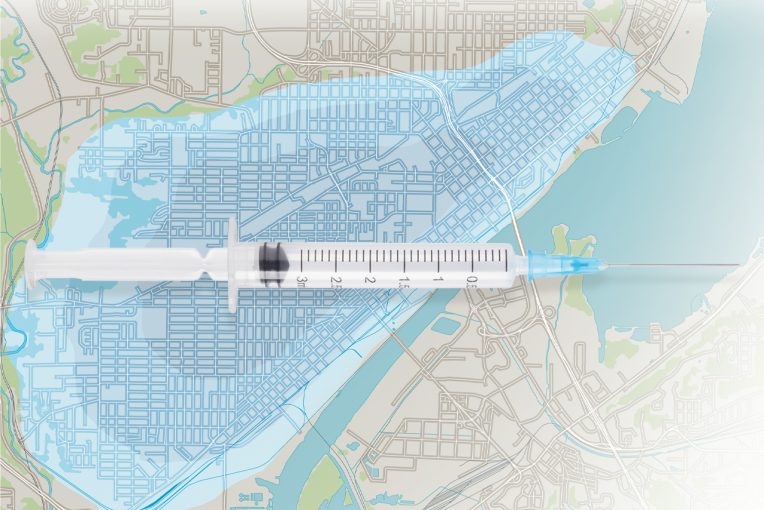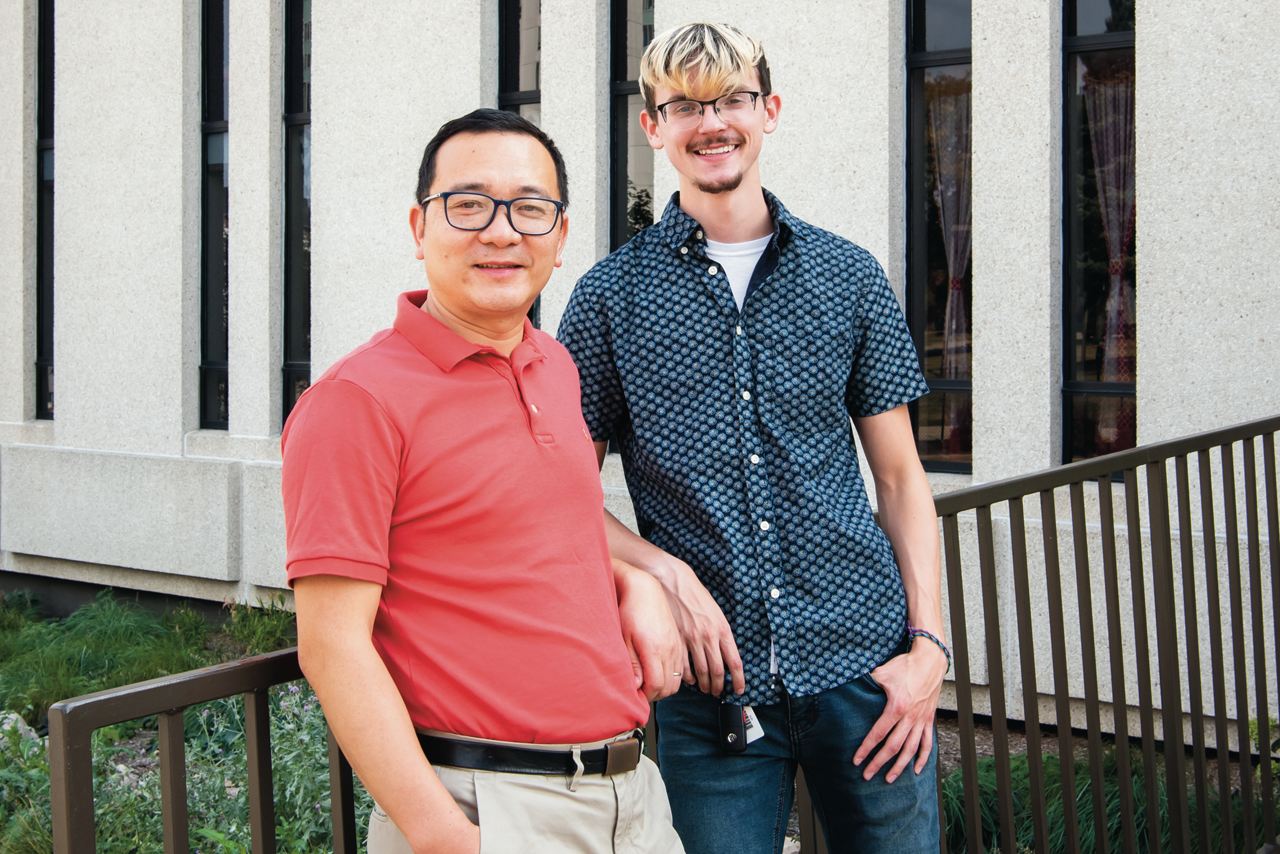A complex project involving machine learning and cooperation between a few of Central Illinois’ largest institutions began with a simple question: How can OSF HealthCare get more children vaccinated?
Staff at the health care provider, which operates facilities across Illinois and Michigan, were worried that more kids every year, especially those in underserved communities, were not being immunized against otherwise preventable diseases such as polio, whooping cough, and measles. For some illnesses, child vaccination rates were falling below 50 percent, said Elise Albers, manager at OSF’s Children’s Hospital of Illinois in Peoria.
“We just noticed that within our health care system, vaccination rates are low, and it can’t just be a problem with us,” Albers said. “That’s just really not acceptable and something that we all wanted to work together to improve.”
The situation became direr during the height of the coronavirus (COVID-19) pandemic. Child vaccination rates plummeted as doctor visits fell, according to Dr. Mary Stapel, medical director of OSF HealthCare Community Care and Hospital Outpatient Departments. “There are levels of herd immunity that we think we need to be at for each different vaccine-preventable illness. Generally, they’re well over 75% to have herd immunity. So if you don’t have that, then you do risk the possibility of preventable outbreaks.”
Appears InThe declining vaccination rates led OSF Healthcare’s Jump Design Lab, headed by Scott Barrows, to begin exploring possible solutions to the problem by meeting with Illinois Innovation Network Hubs in Central Illinois. The state-backed groups had just been launched at universities and community colleges across the state to boost Illinois’ economy through entrepreneurship and research.
Through meetings with Illinois State’s Innovation Hub, Barrows connected with Dr. Shaoen Wu, the State Farm Endowed Chair of Cybersecurity in Illinois State’s School of Information Technology. Barrows’ group and Wu have since partnered with the University of Illinois College of Medicine at Peoria, where Barrows and Stapel are faculty, and the University of Illinois at Urbana-Champaign to develop a project in which machine learning would be deployed to accurately identify populations and locations where child vaccination rates are low and then direct staff on where, when, and for which vaccines to hold mobile clinics.
Wu and undergraduate researcher Evan Hazzard have been creating multiple artificial intelligence tools as part of the project. There will be a heat map to identify geographic hotspots where vaccinations are low, and a user interface that will allow OSF to automatically schedule vaccination clinics and monitor its own vaccination supply.
“Our project is going to visualize and examine the available inventory of vaccinations and the needs in different areas to provide insights for the mobile units,” Wu said.
Hazzard joined the project last summer through an undergraduate research grant from Illinois State’s Office of Student Research. The junior computer science major has been working to create a machine learning tool that would leverage loads of demographic information collected by OSF staff and other organizations on under-immunized pediatric patients to identify where vaccination clinics should be held.
“Basically we’re going to feed this statistical model a bunch of demographic information on the people in a certain neighborhood and what vaccines they already have and give all that information in one big spreadsheet to this statistical model, and it’ll predict for us, ‘OK, you should go to this neighborhood and you should take this path,’” Hazzard said. “And we’re still in the early stages of planning that out, so we don’t know exactly what that model will look like or what information it will predict but that’s the general idea: Give it data, and it’ll give you a summary of your best course of action.”
“Our project is going to visualize and examine the available inventory of vaccinations and the needs in different areas to provide insights for the mobile units.”
Evan Hazzard
OSF staff will be able to see changes in vaccination rates in real time, and then use past data to help direct where future vaccination supplies and clinics will be needed.
“We’ll use that heat map to help us identify which communities, which families are in greatest need, and then schedule vaccination clinics in locations that are convenient for them and in locations that are comfortable for them as well,” Albers said. “I think that we’ll use this information to work with community partners to show them the need and see how they want to be involved in the solution as well.”
OSF is leveraging the project to qualify as a vaccine supplier and distributor through the Vaccines For Children (VFC) program, a federally funded, state-administered program that provides free vaccines to eligible children. Currently, OSF must partner with local VFC programs, such as public health departments, when conducting mobile clinics.
“Part of the VFC program is you order vaccines based on what you need or anticipate using,” Albers said. “So that is why predictive modeling is so important to us in this project because it will help us identify which vaccines to have on hand.”
The project is expected to be fully online this summer and will be targeted to high-risk areas in Central Illinois with the goal of expanding the program statewide. Stapel said national trends are mirrored locally in terms of vaccination rates. Rural and urban areas tend to have lower rates than suburban areas, and children in families living under the poverty level are less likely to be vaccinated than their wealthier peers.
The project has received funding from OSF’s Jump Applied Research for Community Health through Engineering and Simulation, the Illinois Innovation Network, and the U.S. Health Resources and Services Administration (HRSA). Through the HRSA award, the OSF team is also networking with similar groups across the country and helping to develop a national model for mobile vaccination programs, according to Barrows.
“I feel really excited about the project, because in the past, most of our research projects are more fundamental,” Wu said. “For this collaboration with the organization, we can see the immediate impact once the project is done.”
Barrows said this project is just the beginning of what will hopefully be a long-running collaboration with Wu and Illinois State. Barrows’ team is also working with Joanna Willett, assistant director of Mennonite College of Nursing’s Nursing Simulation Laboratory and an OSF nurse, on a couple of grants, one of which involves Dr. Roy Magnuson, associate director of the Creative Technologies Program and associate professor of music composition. Magnuson has created virtual reality tools for music composing and conducting, and now he is being tasked with creating a virtual simulation that would address alarm fatigue among nurses.
OSF and Wu have also applied for National Science Foundation funding for a project focused on endocrinology and machine learning.
“We are creating an innovation spike in Central Illinois,” Barrows said. “This is really exciting. This will just continue.”


